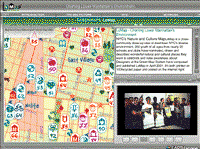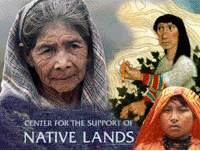
What's New
![]()
Conferences
Press
Resources
Archives
![]()
Geo-story Design
Maps
Text
Media
BFI's
EARTHscope distributed as part of viral web campaign about alarming losses
of biodiversity
A new and much simplified version of EARTHscope™ has been developed
to feature geo-stories about key fronts in the race to protect the web
of life. The EARTHScope content is part of an online campaign focused
on human induced mass extinction, an issue that has reached crisis proportions
but has yet to reach a tippping point of public awareness like global
warming.
BFI's web based geo-story telling tool was incorporated into the campaign
as a way to provide a 'learn more' option to viewers of The
(Bio) Da Versity Code, an animated parody of The Da Vinci Code which
serves as a highly engaging front end to the campaign. BFI produced the
accompanying geo-stories with scientific and editorial advice from the
Center for Health and the Global Environment at Harvard Medical School.
A notable group of leading conservation organizations is participating
in a coordinated e-blast to approximately 1,000,000 constituents to launch
the campaign. Launch partners include the World Wildlife Fund, Sierra
Club, Environmental Defense, The Center for Biological Diversity, The
World Conservation Union, The Endangered Species Coalition, and the Species
Alliance.
The EARTHscope™ presentation begins with a short narrated slide
show overview of the extinction issue which takes viewers to an elegant
map based navigation scheme featuring a choice of two different versions
of the Fuller Projection. There are 5 geo-stories to choose from, three
explore threats to and conservation of three distinct yet related ecosystems;
mangrove forests, the amazon rainforest, and coral reefs, and two delve
into significant drivers of biodiversity loss; global warming and invasive
species.
Each geo-story contains an introductory narrated slide show and five to
eight chapters or sections complete with text, references, pop-up maps,
charts, photos and hyperlinks. The content provided to date for such a
complex and far reaching topic is just the tip of the proverbial iceberg.
Fortunately, the new EARTHscope platform makes it cost effective and simple
to add new content modules.
The campaign was funded by the Threshold Foundation which is seeking to
use new media to proactively address societal awareness of mass extinction
and our responsibility in creating and reversing it.

EARTHscope
Update Winter 2005/06
We are proud to announce the launch of two geo-stories. These presentations
feature the ES engine and an updated interface.
The great feedback we received from our content partners at Native Lands and Green Map System helped us improve the EARTHscope's usability, and led to developing features (such as more flexible content delivery and "jump-to" map navigation ) for more powerful map-based presentations. We've also added IMS integration to the EARTHscope's capabilities, greatly expanding our geo-storytelling capabilities. See below for details.
The complete LoMap geo-story will soon be online! This interactive version of Green Map System's popular youth map features neighborhood close-ups, over 100 pop-up site descriptions, in-depth information on the story behind the map, and tools for starting your own Green Mapping project.


Geo-story
Demo: Native Lands
Check out Mapping for Indigenous Empowerment and Conservation, produced
in collaboration with the Center for Native Lands. This geo-story highlights
Native Lands' groundbreaking work with native peoples to map their own
territories to help preserve tribal territories, cultures, and ecosystems.
This geo-story features regional maps (first published by National Geographic) and recently completed local maps of the Kuna Yala people in Panama. The final version will include expanded content and a Spanish translation.
We are delighted to report that the ES Team has successfully integrated Internet Map Service (IMS) technology with basic GIS (Geographic Information System) functionality into EARTHscope's Flash platform. This step is a result of the talented efforts of Phillip Mielke (GIS developer for the EARTHscope team), with the support of Robert Flores at ESRI (world leaders in GIS).
GIS/IMS-Enabled
EARTHscope
Since Flash uses vector graphics as an efficient graphic display format
it makes for a natural evolution to integrate GIS formatted data (vector
shape files exported to TIFFs) into the Flash environment. We recently
built IMS functionality into EARTHscope to allow seamless importation
of shape files from any map server in the world, such as through the Geography
Network. This will allow students and teachers to easily import GIS
data as they prepare maps, graphs, text, and images for a complete presentation
powered by EARTHscope. At each level of zoom, from global to local, IMS
technology redraws the map to match the resolution of available data.
An ES/IMS demo featuring the world's most accurate global population data
set is in the works. Stay tuned for updates!
EARTHscope in Print
Latest EARTHscope Info Sheet LoRes
408k pdf>>> | HiRes
2.3m pdf>>>
EARTHscope Kiosk LoRes
608k pdf>>> | HiRes
1.1m pdf>>>
ES-SP: Geostory Self-Publishing System Whitepaper LoRes
283k pdf>>>
ES Project Overview HiRes
2.3m Word doc>>>

and the leading edge of our spaceshipEARTH initiative.
